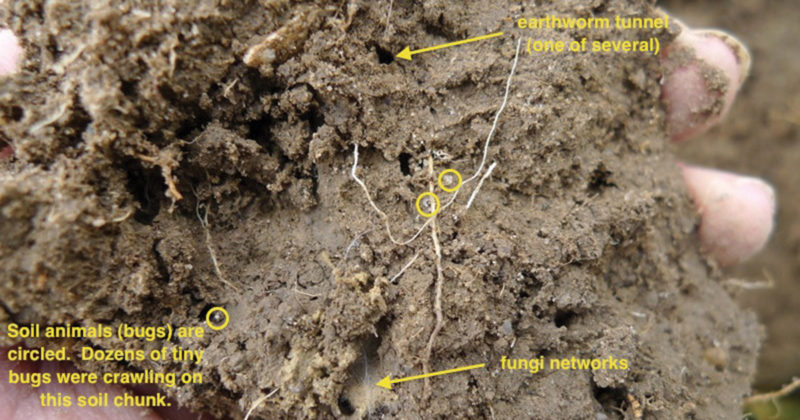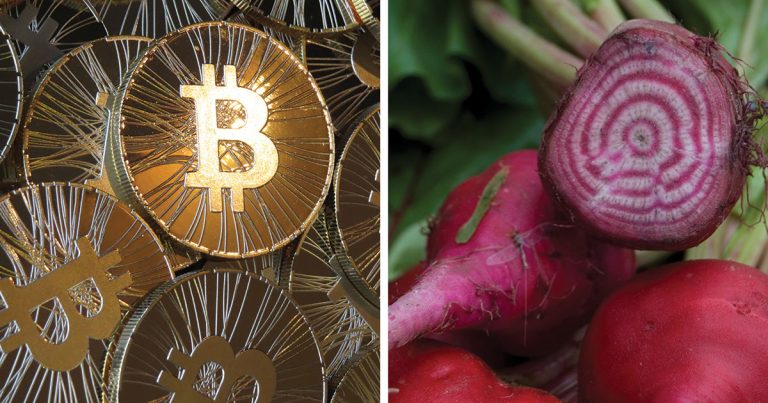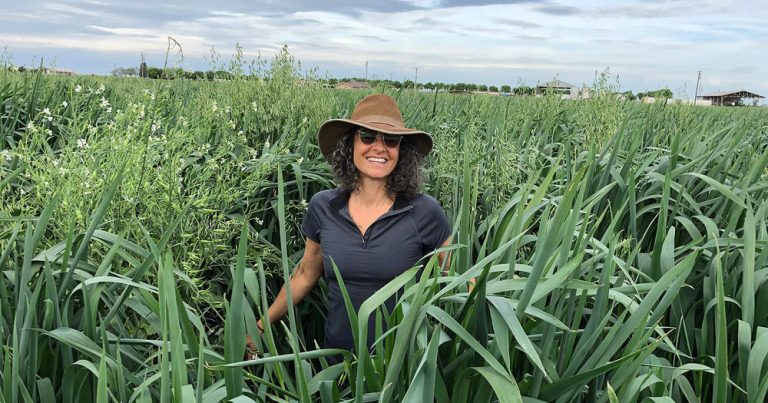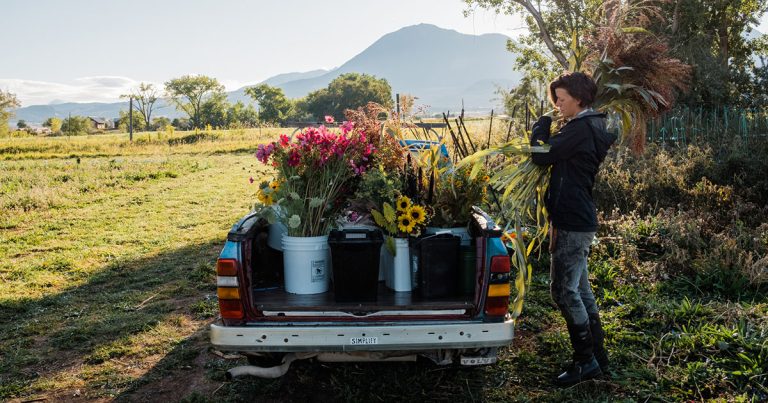Tuesday, June 20 • 8 min read
Real Billions and Real Trillions

Woody Tasch
Founder, Slow Money Institute

While I was searching for images of life in the soil, I came upon the following on Sweet Bay Farm’s website (see above). They’re working to restore soils depleted by decades of monoculture—the continual cultivation of a single crop, in this case tobacco—so this picture of several earthworm tunnels in a clod does not yet suggest anything teeming. Charles Darwin’s observation, in his last manuscript, is instructive with respect to the magnitude of earthworm populations in general:
Hensen, who has published so full and interesting an account of the habits of worms, calculates, from the number which he found in a measured space, that there must exist 133,000 living worms in a hectare of land, or 53,767 in an acre. This latter number of worms would weigh 356 pounds, taking Hensen’s standard of the weight of a single worm, namely three grams. It should, however, be noted that this calculation is founded on the numbers found in a garden, and Hensen believes that worms are here twice as numerous as in cornfields. The above results, astonishing though they be, seem to me credible, judging from the number of worms which I have sometimes seen.
But Darwin’s numbers were only the beginning. In 1951 (the year this author joined the ranks of the Baby Boomers), observers of pastureland in Scotland estimated the number of earthworms per acre to be 100,000 to 200,000. Today, the United States Department of Agriculture Natural Resources Conservation Service (NRCS) reports that the number of earthworms per acre of cropland can exceed a million, if the land is “highly organic.”
The NRCS cites the following beneficial soil fertility services performed by earthworms:
Stimulate microbial activity. Although earthworms derive their nutrition from microorganisms, many more microorganisms are present in their feces or casts than in the organic matter that they consume. As organic matter passes through their intestines, it is fragmented and inoculated with microorganisms. Increased microbial activity facilitates the cycling of nutrients from organic matter and their conversion into forms readily taken up by plants.
Mix and aggregate soil. As they consume organic matter and mineral particles, earthworms excrete wastes in the form of casts, a type of soil aggregate. Charles Darwin calculated that earthworms can move large amounts of soil from the lower strata to the surface and also carry organic matter down into deeper soil layers. A large proportion of soil passes through the guts of earthworms, and they can turn over the top six inches (15 cm) of soil in ten to twenty years.
Increase infiltration. Earthworms enhance porosity as they move through the soil. Some species make permanent burrows deep into the soil. These burrows can persist long after the inhabitant has died, and can be a major conduit for soil drainage, particularly under heavy rainfall. At the same time, the burrows minimize surface water erosion. The horizontal burrowing of other species in the top several inches of soil increases overall porosity and drainage.
Improve water-holding capacity. By fragmenting organic matter, and increasing soil porosity and aggregation, earthworms can significantly increase the water-holding capacity of soils.
Provide channels for root growth. The channels made by deep-burrowing earthworms are lined with readily available nutrients and make it easier for roots to penetrate deep into the soil.
Bury and shred plant residue. Plant and crop residue are gradually buried by cast material deposited on the surface and as earthworms pull surface residue into their burrows.
Earthworms are joined in the soil by many other invertebrates, including millipedes, centipedes, springtails, grubs, beetles, and snails. But the first point in the above list of earthworm functions, referring to the stimulation of microbial activity, is our conceptual wormhole to a whole other realm—the realm of myriad soil creatures that we cannot see with the naked eye. This is, truly, the realm of teeming. Bacteria, fungi, protozoa, nematodes, mites, microarthropods—there can be 10,000 to 50,000 species in less than a teaspoon of soil. That’s species. In terms of individuals, there are more microbes in a teaspoon of soil than there are humans on earth. Bacteria, actinomycetes, and fungi in an acre of soil can weigh thousands of pounds. Some estimates suggest that microbes account for half the weight of all life on earth.
David Suzuki’s The Sacred Balance offers the following:

Microorganisms also live in the guts of earthworms—500,000 or so per worm. They are found in more astonishing numbers in the guts of humans. Recent studies indicate that 1,000 species and tens of trillions of microbes live in the human digestive tract, with as many as 100 trillion in total occupying each human body. Multiply this by the global human population of 7 billion or so and you arrive at an astounding 700,000,000,000,000,000,000,000,000, if I have the zeroes right, which I may not. Is that 700 septillion? Such a name seems far too reductionist for the enormity it denotes.
The names of big numbers don’t do justice to our understanding of the underlying nature of things. Take trillions, for example. We talk of wars costing trillions of dollars and the U.S. gross domestic product of $18 trillion and world economic output of $75 trillion and $250 trillion of total global financial assets and trillions of dollars a day flowing through currency markets. But do we really know what the number one trillion means? Do we have any frame of reference that can give this number a context to which we can relate?
I know I didn’t until my encounter with Jerome McGeorge, friend and financial advisor to George Siemon and Theresa Marquez, leaders of CROPP, the $1 billion farmer-owned cooperative behind the leading organic food brand Organic Valley.
“I want to see what Jerome thinks of Slow Money,” George said to me, as we drove up to a rustic home outside La Farge, Wisconsin.
Here’s how one journalist describes Jerome:
Jerome McGeorge, a 70-year-old man with long white hair and a wispy beard, is the wizard I’m looking for. He was a founding member of Coulee Region Organic Produce Pool (CROPP), the cooperative that owns the Organic Valley brand, and an old hippy straight out of the Summer of Love. One moment he is describing the revolutionary spirit of late 1960s San Francisco, the next he’s on to peak food, the price of organic milk in Europe, mission versus profit motivated enterprises, and the long, slow death of the family farm during his lifetime.
I’ve long forgotten what I said to Jerome during that visit, perhaps because I was taken aback by his soothsayerly demeanor. Was I to take him seriously? Was he to take me seriously? Would he dismiss my explanations of fast money and slow money as mumbo jumbo? His reception proved far too warm for any such anxiety to linger.
“Here’s something that you need to know,” Jerome said to me. “I’m going to start you out with a fact, and then ask you two questions. The fact is, A million seconds equals 12 days. The first question is, How long is a billion seconds?”
I don’t remember if I came up with the correct answer: 12,000 days, otherwise known as 32.9 years.
“Now, here’s the second question,” Jerome continued, “How long is a trillion seconds?” Again, I don’t remember if I came up with the correct answer: 32,900 years.
A million seconds equals 12 days and a trillion seconds equals 32,900 years. That’s how much bigger a trillion is than a million.
Expressing the quantity one trillion as time instead of as an imaginary stack of dollar bills makes it somewhat more comprehensible. For instance, a stack of one trillion dollar bills would be 67,866 miles high, reaching a quarter of the way to the moon. This is remarkable, to be sure, but it doesn’t quite tickle my imagination the way this does: If someone had lent Jesus $1 trillion at zero percent interest on the day he was born, and it was to be paid back by him and those who came after at the rate of $1 million per day, payments would still have more than 500 years to go.
I’d worked in a small venture capital fund in New York City in the 1980s and as treasurer of a $60 million foundation in the 1990s and with a national network of sustainability-minded angel investors for another decade, reviewing who knows how many business plans with financial projections showing hundreds of millions of dollars or more of sales within five years, but until that day in Jerome’s living room decades later, I didn’t have an authentic feel, a wizard-enhanced feel, for the implications of billions and trillions.
In terms of money and the flow of capital through complex securities, millisecond computer trades, and financial institutions that are Too Big To Fail, trillions means mind-numbing.
In terms of microbes and life in the soil, trillions means teeming.



